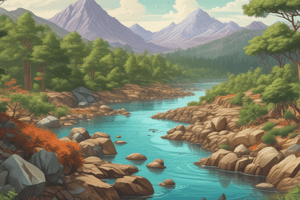Podcast
Questions and Answers
What is biodiversity primarily composed of?
What is biodiversity primarily composed of?
- Variety of living things, number of kinds, ecological diversity, species diversity, and genetic diversity (correct)
- Only species diversity
- Only ecological diversity
- Only genetic diversity
Approximately how many species are estimated to exist on Earth?
Approximately how many species are estimated to exist on Earth?
- 200,000
- 100,000
- 1.7-2.0 million
- 100 million (correct)
What is unique about the biodiversity found in the tropics?
What is unique about the biodiversity found in the tropics?
- No unique species found
- Low concentration of species
- Dense concentrations of species (correct)
- Only a few species of birds
Why is it essential to preserve biodiversity?
Why is it essential to preserve biodiversity?
What is one benefit of preserving biodiversity?
What is one benefit of preserving biodiversity?
What is one way in which humans benefit from biodiversity?
What is one way in which humans benefit from biodiversity?
What percentage of angiosperm species on Earth are used as a food source?
What percentage of angiosperm species on Earth are used as a food source?
What is one way in which genetic resources from biodiversity are used?
What is one way in which genetic resources from biodiversity are used?
What is the biosphere?
What is the biosphere?
What is transferred from one level of the food chain to the next?
What is transferred from one level of the food chain to the next?
What is excluded from bioresources?
What is excluded from bioresources?
What is biomass?
What is biomass?
Why is bioresources management and utilization important?
Why is bioresources management and utilization important?
What is the importance of awareness of bioresources?
What is the importance of awareness of bioresources?
What could be a potential source of new medicines?
What could be a potential source of new medicines?
What is one way humans indirectly contribute to species extinctions?
What is one way humans indirectly contribute to species extinctions?
What is desertification?
What is desertification?
What is one effect of acid rain?
What is one effect of acid rain?
What is one result of climate change?
What is one result of climate change?
What is a potential new food source from the ocean?
What is a potential new food source from the ocean?
What is one way to protect biodiversity?
What is one way to protect biodiversity?
What is bioenergy?
What is bioenergy?
What is a cause of water pollution?
What is a cause of water pollution?
What is one effect of pollution?
What is one effect of pollution?
What is one way to prevent overharvesting?
What is one way to prevent overharvesting?
What is the main goal of ecological restoration?
What is the main goal of ecological restoration?
What is the name of the programme in Malaysia that aims to conserve biodiversity?
What is the name of the programme in Malaysia that aims to conserve biodiversity?
What is the main objective of Malaysia's National Policy on Biological Diversity?
What is the main objective of Malaysia's National Policy on Biological Diversity?
What is an example of ecological restoration?
What is an example of ecological restoration?
What is the purpose of refuges, parks, and preserves?
What is the purpose of refuges, parks, and preserves?
Flashcards are hidden until you start studying
Study Notes
The Biosphere
- The biosphere is the "life zone" of the Earth, including all living organisms, organic matter, and extending from the atmosphere to the depths of the oceans.
- It is structured into a hierarchy known as a food chain, with energy and nutrients transferred from one level to the next.
Bioresources
- Bioresources are any resources of biological origin, excluding fossil fuels and rocks of biological origin.
- Examples of bioresources include biomass, wood, agricultural crops, herbaceous and woody energy crops, municipal organic wastes, and manure.
- Bioresources are important for national progress and economic activities, and their management and utilization are crucial for human welfare.
Biodiversity
- Biodiversity refers to the variety of living things, including different species, habitats, and genes.
- There are estimated to be between 1.7 and 2.0 million species, with some estimates suggesting up to 100 million.
- Biodiversity is essential for human health, as it provides ecosystem services such as producing oxygen, removing CO2, decomposing waste, and preventing erosion and flooding.
- We benefit from biodiversity in various ways, including through medicines, genetic resources, and aesthetic and cultural values.
Benefits of Biodiversity
- Genetic resources: 350,000 species of angiosperm on earth, with 80,000 possessing food value and 3,000 used as food sources.
- Livestock genetic resources: important for crop improvement, increased production, disease resistance, and drought tolerance.
- Potential new food sources: from plants and animals.
- Medicines from plants and animals: 50% of medicinal compounds are obtained from plants, and often difficult or expensive to artificially synthesize.
- Bioenergy and biofuels: biomass, maize, saccharum, miscanthus, and salix.
Impacts of Human Activity on the Biosphere and Bioresources
- The increasing size of the human population and industrialization have far-reaching effects on the biosphere, including extinction of individual species and global climate change.
- Humans are indirectly/directly increasing the rate of species extinctions through habitat destruction, overharvesting, and introducing exotic species.
Threatened Species
- Endangered species: face extinction in all or part of their range.
- Threatened species: likely to become endangered in the near future.
- Endemic species: evolved in one place and found nowhere else.
Global Impact of Human Activities
- Human activities threaten entire ecosystems, including desertification, deforestation, air pollution, acid rain, water pollution, and trash in aquatic ecosystems.
- Desertification: poor agricultural practices turn grasslands or woodlands into deserts.
- Deforestation: human activities strip woodlands of trees, leading to flooding, landslides, and increased atmospheric CO2.
- Pollution: human activities generate pollutants that kill animals and damage ecosystems, including plastics, chemicals, and heavy metals.
Protecting Bioresources and Biodiversity
- Stop overharvesting and adopt sustainable yield practices.
- Protect habitats through refuges, parks, and preserves.
- Ecological restoration can help actively recreate or renew a diverse natural ecosystem.
- National policies, such as Malaysia's National Policy on Biological Diversity, can help conserve and sustainably utilize biological diversity.
Studying That Suits You
Use AI to generate personalized quizzes and flashcards to suit your learning preferences.




